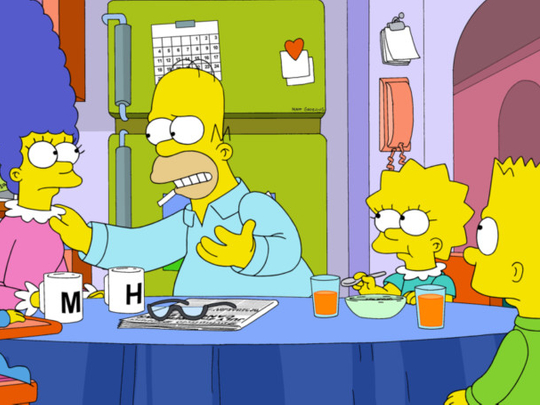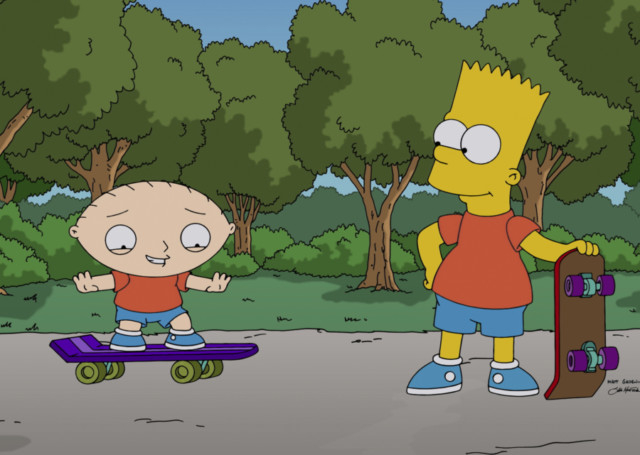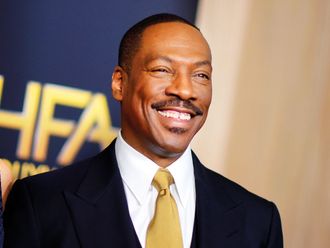
Conservatives branded it an assault on family values. The nation’s drug czar warned recovering addicts not to watch it. Schools barred clothing featuring its images.
But when The Simpsons premieres its 26th season on Sunday, TV’s longest-running prime-time series will have the last laugh.
Fox’s animated comedy about a middle-class clan headed by a lovably dim-witted patriarch named Homer has grown into one of America’s defining cultural institutions. It’s also become a commercial behemoth worth more than $12 billion (Dh44 billion), with a booming merchandise line selling everything from branded Lego sets to fashion accessories to toy cars.
Beyond the numbers, The Simpsons also changed entertainment, hurling pop-cultural savvy and knowing irony into prime time and opening animation — formerly a Saturday-morning TV ghetto for kids — as a playground for adults as well. Expressions such as “D’oh!” and “Woo-hoo!” entered the lexicon. And the series launched a wave of successors, including Family Guy, South Park and Cartoon Network’s smash Adult Swim franchise.
“Historically, animation had been pretty much aimed at children,” said Matt Groening, the show’s creator. “Nobody quite knew how to handle a cartoon that was aimed at adults.”
Suddenly, “family entertainment didn’t have to have jokes for the youngest member of the family,” he added. “There were jokes that adults would get.”
Many of the younger adults now sought by advertisers weren’t even born when the series premiered in 1989. The show has managed to thrive even amid accusations of creative decline and ebbing numbers for network TV overall.
When The Simpsons debuted, Fox was a scrappy fourth network, and barely half of US households had access to cable TV. In 2013, 83 per cent of American households were paying for multichannel TV through a pay service, according to the Consumer Electronics Association. Prime time, a territory Groening & Co once had to themselves, is now chock-a-block with animated offerings from Rick and Morty to Bob’s Burgers.
The Simpsons has also survived several testy salary disputes for the actors who voice Homer, wife Marge, disobedient and sarcastic son Bart, smart, vegetarian daughter Lisa and (the mostly silent infant) Maggie as well as the other several hundred characters who live in fictional Springfield. Those performers were making more than $400,000 per episode, or more than $10 million per year, before an estimated 30 per cent cutback in 2011.
Yeardley Smith, the 50-year-old actor who has been voicing Lisa for half her life, said she has not enjoyed seeing the details of her salary splashed all over the news. But it has been an annoyance she sees as inevitable given how deeply The Simpsons is woven into the culture — not just in America but around the world. Earlier this year, top European soccer teams announced Simpsons sponsorship deals in advance of the World Cup.
‘Extraordinary familiarity’
“Lisa wears the same strapless red dress, pearls and Mary Janes to school every day,” Smith said. “It perpetuates an extraordinary familiarity.”
That longevity was hardly foreseeable when The Simpsons premiered on December 17, 1989.
The characters were created by Groening, a Los Angeles-based cartoonist then best known for an absurdist comic strip called Life in Hell. The comic starred Binky, a crudely drawn, anthropomorphic rabbit whose hopes collide with a bleak, sardonic vision of modern urban life. Life in Hell appeared in alternative papers across the nation and became a hit among college students. Key to its appeal was reinventing the cartoon format with a sophisticated sense of absurd comedy, something that would later be crucial to The Simpsons.
James L. Brooks, the TV producer who was a guiding force behind The Mary Tyler Moore Show during the 1970s, was by the late 1980s working on a Fox variety show starring British comic Tracey Ullman. Brooks had admired Life in Hell and asked Groening if he would be interested in doing some animated shorts to drop into Ullman’s show.
The original idea was simply to animate the Life in Hell comic, but Groening ultimately rejected that.
“I was sceptical that any TV show would last, and I thought, ‘What if this was a fiasco?’” he recalled. “I didn’t want the animation to ruin my comic strips, so I thought, ‘I’ll make up something new.’”
He settled on the idea of a typical American family, borrowing real names from his own, including changing his mother’s from Margaret to Marge and his own from Matt to Bart (the latter name’s closeness to “brat” was a deliberate choice, he has said). The drawing was primitive, as it was on Life in Hell. All the characters had yellow fleshtone and enormous eyes with pinholes for pupils. Homer’s paunch was visible through his white polo shirt; a couple squiggly lines atop his head indicated thinning hair. Like Fred Flintstone, he had a dark ring around his mouth to suggest a five o’clock shadow.
The characters — which first appeared on Ullman’s show on August 19, 1987 — proved so popular that Fox hired Groening, Brooks and writer-producer Sam Simon to develop a sitcom around them, to premiere in late 1989. For inspiration, Groening was reaching back even further than The Flintstones.
“I was thinking about the sitcoms I grew up with,” Groening said. “On The Andy Griffith Show, there was the town of Mayberry, which had a barber and a town drunk and everything. You really got to feel that that was a real place. I thought it would be really cool in animation if we could populate that town in which the Simpsons lived.”
The town ended up with hundreds of supporting characters. Among them: Krusty the Clown, a world-weary children’s TV host; Sideshow Bob, a maniacal villain voiced by Kelsey Grammer; and Mr Burns, Homer’s evil, money-grubbing boss at a nuclear power plant.
Immediate hit
The reaction from viewers was immediate. The Simpsons was a smash shortly after it debuted, the first programme from the then-young Fox network ever to hit the Top 30. The Simpsons — along with Rupert Murdoch’s early 1990s purchases of large station groups — finally proved Fox was a viable network after several shaky years.
But the reception wasn’t entirely positive. The Simpsons became a favourite target of conservative critics. Bill Bennett, then the US drug policy director, told recovering addicts not to watch the cartoon. Bart Simpson, said Bennett, who later went on to pen The Book of Virtues, is a poor role model.
President George H.W. Bush, running for reelection on a family-values platform in 1992, said his goal was “to make American families a lot more like the Waltons and a lot less like the Simpsons.” A number of schools across the country banned Simpsons-branded clothing, with administrators especially disdaining T-shirts with Bart’s image and the slogan: “Underachiever (and Proud of It, Man).”
Although very few TV shows make more than a ripple in the wider culture, The Simpsons is among the exceptions. Comedy writers noticed the impact that The Simpsons was having. One of them was a young stand-up comic, Seth MacFarlane, who went on to create Family Guy, which profitably expanded on The Simpsons formula. Together, both shows anchor Fox’s lucrative Sunday-night animation line-up.
The question now is how long Fox will keep Springfield and its most famous family alive.
Some critics have charged that the show’s glory days are long past, that in recent years producers have traded away a focus on character development and sharp satire to load up instead on silly gags and celebrity guest stars. Ratings have steadily declined, from 27.8 million in Season 1 to 13.5 million in Season 10, 6.9 million in Season 20 and down to 5.7 million in the just-concluded Season 25. That type of erosion isn’t uncommon, however, in broadcast TV.
“What’s remarkable is that entirely new generations are still discovering this series, be it through the mobile game, the web portal or the [Labour Day] marathon on FXX,” Dana Walden, Fox Television Group chairman and chief executive, wrote in an email. “And the Sunday night original continues to deliver ratings that make it one of the most powerful comedies on the air.”
The writers have chosen to kick off the landmark 26th season with the death of a well-known character. It’s a familiar stunt for ageing shows and one that Family Guy tried with its popular Brian the dog (though it almost instantly brought him back). Al Jean, the writer-producer who has supervised day-to-day production of The Simpsons for years, promises the character will stay dead.
The Simpsons Movie in 2007 was a worldwide hit, but Jean said there are no plans for a sequel.
“That’s the furthest thing from our thoughts at the moment,” he said in an interview.
But a recent weekend of special Simpsons live shows at the Hollywood Bowl got the producers thinking about a Broadway version, he added.
As for the TV series, it finds itself in the unprecedented position of thriving amid a TV landscape radically changed from the one in which it was created a quarter-century ago. The show will continue at least through the end of 2015, according to network officials.
“We try to come up with new angles on familiar topics and tell jokes that we haven’t told before,” Groening said, admitting: “It’s hard after 552 episodes of a family that never ages to keep those surprises coming.”
On the other hand, “I still don’t see an end to the show,” he added. “Every year, it seems like we got another chance to keep going.”
The Simpsons airs in the UAE on Star World HD every Saturday at 3.30pm.











